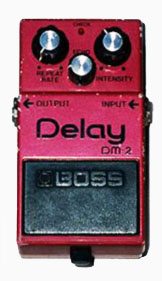Bonus Question answer
Last time around, our bonus question was this:
Where was the first echo (or delay) effect first manufactured?
If you have been following the Hearing Effects series so far, then you’ll know by now that nothing has a clear-cut answer. There is always too much debate about who really did what, and who really did what when; and this is even among the official records’ archivists!
However, regardless of who first “pioneered” the echo effect; the first to commercially manufacture it was Ray Butts in the early 1950s, who designed and built his wire-based echo machine into guitar amplifiers. (There might be someone out there to dispute that, but most fingers point to Ray.) It is a common mistake that the “echoplex” distributed by Maestro was the first, but that mix up is understandable since the “echoplex” holds the popularity award, and is still certainly regarded as the “Holy Grail” of echo effects.
This leads us straight into our next topic of echo/delay/reverb effects. Smooth, aren’t I?
Inspired by Nature
Alright, let’s dive right in. Everyone knows the sound characteristics of, say, yelling in a giant stadium or a cavern, or even out in the open high mountain ranges (for those who have actually experienced the wonder of something like the Grand Canyon).

Nature has built-in reverberation. For each different environment, sounds behave accordingly. The larger, more open and unobstructed spaces produce a longer delay between the sound and the bouncing around of that sound that reaches back to your ears. Those reflections can take a few milliseconds or up to a second or two to reach back to you. Once they do: Ta-Da! Instant reverb/echo!
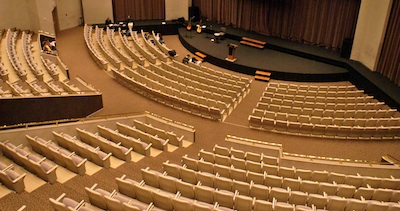
Clap your hands in a large empty auditorium. Hey, where did all those other claps come from?
I won’t belabor the descriptive prose any more, as we are all aware of nature’s sound characteristics.
The fun all began when musicians/engineers/scientists asked “how can we replicate that effect electronically?” – seem like a familiar question? After all, it’s would be a lot easier to electronically simulate an open hall reverb electronically than it is to set up your studio in the middle of a giant cave!
As with anything, convenience, ease of use, and portability led to the invention of… Well, just about everything if you really want to get philosophical. But, we aren’t here to discuss Plato. We are here to learn about the different electronic gizmos that delay, echo, bounce, reflect, and expand our sounds.
Our first order of business (as per usual) is to define the basic archetypes for these effects.
The two basic archetypes are:
- Echo/Delay
- Reverberation (or “Reverb”)
The difference being simple but quite crucial!
Echo/Delay effects produce a distinct repetition (or repetitions) in the sound at certain time intervals.
Reverb effects on the other hand, produce a continuous, smooth expansion of sound without the individual repeats.
That in a nutshell is the distinction between the two. You know what’s coming next… The variations spawned by these two main archetypes are numerous, constantly evolving, and sometimes blur the line between the two.
Let’s take a look at the basic “must know” information. We’ll start with the echo/delay effects this week, and move onto reverb next time.
Echo through the years
The earliest way to get an echo/delay effect was to run two analog tape machines in synchronized tandem, and then tapping on one of the tape “flanges” (remember that word for the next article!) to cause a momentary un-synching of the two tapes. Since both tapes were simultaneously fed into the same output, you could distinctly hear the one or two staggered repeats in the signal. Tape echo was born! No-one will argue that the late great Les Paul was the pioneer of this method.
This gave way to the rise of “tape loop” echo effects, which duplicated Les’ invention. All of these effects used the same basic electronic anatomy. Some even used “wire loop” instead of tape, while some were built into amplifiers (Ray Butts’ invention), but ultimately all of these methods used the tried and true method of recording a source signal, and delaying it slightly before passing it out to the output that contained the original signal. That produced a nice dirty, organic echo sound: Analog tape delay.
This was, and still is a very hard act to follow. What made these units so appealing is that the echo repeats have a natural sonic degradation, and gradual distorting of the repeats, much like that of a “real canyon” that nature gives us. Out in the open, you don’t hear crystal clear repeats. You hear that natural decaying and degrading of the sound, so these analog-based tape units were the next best thing to actually “being there”. The peak of the tape echo period was the much sought-after “Echoplex” machine by Maestro.
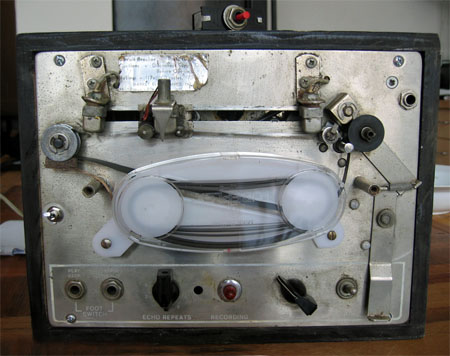
An EP-2 Echoplex tape delay machine (Photo: pheezy/Flickr)
Tape Delays
Now, here are some “need to know” facts about tape “echoes” in general.
While lacking versatility, tape delay systems exploit such technical flaws as tape wear (from repeated use), tape “wow and flutter” (warbling caused by tape stretching and inconsistent motor speed) and tube electronics to add to the initial sound. This dirtying-up of the echo repeats has the desirable sound talked about above, while the tube electronics add a certain “amplifier” tone shaping to the initial (dry) signal, which many people use as a tone shaper in and of itself. For those who didn’t want any coloration to their dry signal, tape delays were built without tube-based electronics. Although they too imparted a certain “something” to the original signal, it wasn’t to the same degree as the tube equipment.
With all the positive and desirable sound characteristics, tape based systems were notoriously fickle and unreliable. They were big and bulky (compared to the small pedal effects we know today). Tape had to be replaced, motors burned out, and general mechanical maintenance was very troublesome – to say the least!
A new alternative was needed.
Enter the Bucket Brigade
The answer was a magic electronic component. I’ll spare the electronic specifications, but here is your required knowledge concerning “Bucket Brigade” technology: This electronic component essentially mimics what the tape delay does. It takes the input signal and passes it through multiple “buckets” which each in turn delay the signal ever so slightly in relation to the dry signal. Each successive bucket adds more delay. The result is a compact, pedal-sized delay effect that mimics tape.
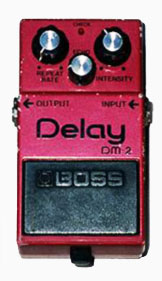
While not as rich, or complex sounding as a real tape system, these delays were still analog and still had a nice warm degradation to the repeats. Plus, the “cash and carry” was much more suited to the average working musician!
The manufacturers tripped over each other to build the latest echo feast. Some great examples were built including the Electro-Harmonix Memory Man, the Roland/Boss DM-2 and 3, and many more from MXR, DOD, and too many others to even think about. Incidentally, some of these “vintage” effects bring in a fortune when sold in original/unaltered condition. And if they are in “mint” condition? Gold mine!
We musicians love to be the center of the known universe. It’s our base nature as performers! If we didn’t possess that natural “life of the party” mentality, we would not be able to perform in front of a strange audience every night, much less put on a good show!
Too bad the rest of the modernized and technological world doesn’t see it like that.
With electronic advancements being made at frightening speed, analog bucket brigade chips were no longer being used in mainstream (non-musical) applications. Everything was going digital.
Analog chips for musical purposes became sparse and therefore went up in price, negating cost effective manufacturing.
The solution? Going digital.
The Modern Era of Echo Effects
The next step in the quest for repeats was digital. Manufacturers suited up, and before you could say “change the tape” produced and flooded the market with the third evolution in delay effects. The Roland/Boss Corporation (which by now had become THE biggest compact effects manufacturer) made instant history with the now-considered “classics,” like the DD-2, DD-3 and so forth. Everyone else jumped into the digital dance.
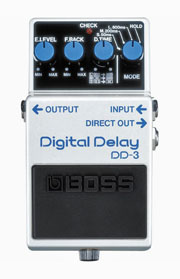
Right around this time (early ‘80s) companies started to build more sophisticated effects units mounted in 19-inch “rackmount” units. These took advantage of the ever increasing power offered by digital processing, leading to the “multi-effect” rack rigs that were targeted specifically at the increasing demands of the versatile musician. That’s a discussion for another time – but I just wanted to frame the reference point.
Analog effects seemed to be losing ground. The battle might have been lost, but the war was far from over. Last time I checked, it is still going strong!
Anyway, my point is this: even though those early digital delays were supposed to do away with all of the shortcomings associated with tape delays, or the lack of features found in analog delays, the sound quality was still far from what it promised.
Early digital data precision was low (8-bit sampling) which contributed some nasty sonic degradation of the repeats. The early units were noisy, and ultimately that analog sound musicians had come to love was just not there. Still, those early digital units are now desired for exactly that reason! Those early digital sonic artifacts are now considered to be one more color in the sonic artists’ palette!
The Next Step
The evolution of delay and echo effects continues today.
Digital delays now are so clean and sampled at such a high rate, that noise is not an issue. Repeats are as crystal clear as you could want (to the point if being indistinguishable from the original source), and the sheer versatility… I would need to write a book on that topic alone!
The ability to accurately mimic analog qualities such as the tape distortion, wow and flutter, bucket brigade warm decays, etc. has arguably been achieved. Companies like TC Electronic, Lexicon, and Eventide are at the forefront of building and manufacturing pretty much “If you can imagine it, it will do it!” delays.
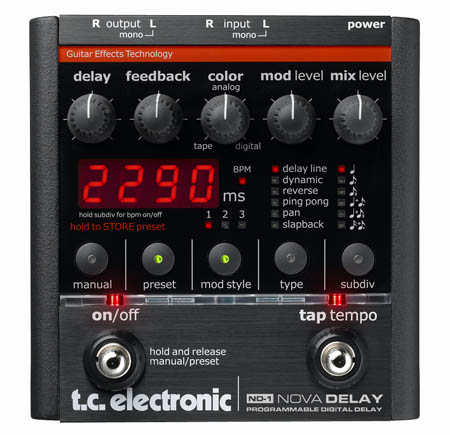
A sophisticated programmable delay from TC Electronic
If that’s not enough, the resurgence of analog has brought bucket brigade technology back into demand. Now you have companies tripping over each other to build bucket brigade analog delays, with all the advantages of digital technology for versatility and endless features. Truly things have come full circle, as basically any delay you could possible want is now available.
Finally, for the hardcore tape fanatics, there is a core group of dedicated manufacturers building real tube-driven delays, and even tube-driven tape delays! The reliability and quality control issues that plagued the units of old are now a thing of the past.
It’s truly a magical time for those who want all things to repeat!
Delay characteristics
That’s enough talk – time for some sounds and summary! Here is a cross section of popular delay/echo characteristics from way back then right up ’til now:
1. Tape Delay with Tube Electronics
- Signal is recorded and played back on a continuous loop tape.
- Delay Time (time between echo repeats) is adjusted by moving the playback head closer or farther away from the record head.
- Tube electronics fatten up the dry (original) signal. Some people like this, some don’t.
- Echo repeats are organic and fat, with a nice degradation and high frequency roll off.
- Pros: Very complex sound.
- Cons: Limited delay time and features. Mechanically unreliable. Expensive!
Pay attention to all of the idiosyncrasies about tape we discussed.
“Slapback” means a very quick repeat – the classic rockabilly sound.
2. Analog type delays (Bucket Brigade)
- Warm analog repeat sound similar to tape (though not as complex)
- Feedback Control sets how many repeats are sent back through the unit. Allows for “spaceship taking off” sounds when set to very high amounts!
- Pros: Compact. Inexpensive. Warm echo sound, with rounded (high frequency roll off). Stable and sturdy. No maintenance.
- Cons: Lacks the complexity of the “tape sound”. Noisy.
Note the warm dark repeats.
3. Digital Delays (old and new)
- Longer delay times.
- Unlimited features. (Tap tempo, note rhythm settings, separate delay lines etc.)
- Ability to reproduce various physical acts, such as backwards delay (reverse delay) which was done by physically placing the recording tape backwards and recording music, then flipping the tape again to play it forward; revealing the “backwards” sound. With modern digital delays – push a button, boom, done!
- Ability to create and store delay presets for easy retrieval of previous setups.
- Pros: All of the above. The only limits are the processing power of the unit. The AD/DA converters (analog to digital and digital back to analog) are extremely high quality, thus passing a noiseless direct tone, with no coloration, as well as allowing “anything” to be done to the repeats, with no unwanted side effects – or with side effects purposely put in!
- Cons: Old digital delays are noisy. Sampled at a very low rate, thus producing what is best described as a “grungy” color to the sound. Although early sampler and looping artists latched on to that lo-fi sound and made it popular!
- Old digital delays degraded the dry signal as well as the repeats. In fairness, the same could be said for analog and tape delays, but that is an argument to the integrity of the input/output electronics and not the “effect” itself.
- Original high end digital delays were EXPENSIVE!
Standard modern digital delay. (16 bit)
Other variations
Multi-head analog delay
(Roland “space echo” and such) has multiple delay points due to having more than one tape head, or simulation circuitry.
One of the most beloved tape echoes. Note the staggered repeats, courtesy of the multiple playback heads (4 of them).
Reverse delay
Flip a tape over with the touch of a button.
A pedal that simulates flipping rolls of tape. Need I say more?
“Ping pong” delay
Delay subdivided and bouncing between the left and right channel.
Listen to how the sound bounces left and right as part of the delay effect.
Stereo delay
Two completely independent delays for left and right channels, with individual delay and repeat controls.
Multi-tap delay
Same as a stereo delay, but instead can have up to 20 or even more individual taps, all with individual controls! Can be used to process a signal with intricate patterns throughout the whole stereo sound field, or even in the multi-channel surround of today.
Rhythmic delay
Delays with the ability to program not just the delay time, but the actual rhythm of the music being processed. TC Electronic is a pioneer of that one.
The classic cascading rhythm effect. Here’s the formula: use 75% of your tempo. For example, if a 400 millisecond delay creates eighth notes at your current tempo, you would set your delay to 300ms instead. Instant dotted 8th note triplets!
All of these variations are available in stand-alone compact pedal format, rack-mounted studio pieces, and of course software plugins for just about any DAW system.
And if I even need to mention this, most if these delays can be either analog or digital – and even both. For instance, TC Electronic has a delay unit that allows the user to set the amount of “digital” or “analog” character to the sound.
In short: even the natural laws of physics are no longer a limiting factor for sound creation!
Sir/madam, what’s your pleasure?
Want a high-quality, high-tech super multi-tap delay that sounds like 10 vintage echoplexes cascaded together, without the tube sound, but with the heavy saturating of the virtual tape; and while we’re at it, have two of those delays be completely ice cold with perfect repeats?
Today it can be done!
And the best part is the price. Years ago, studio quality delays were in the 4 to 5 digits, money wise. Now… well, you know how it goes!
All of these sonic possibilities from the humble quest to add a little “natural echo” to a dry sound!
Next time around: Rrrreeeevvvveerrrrrbbbbbbbbbbb!

